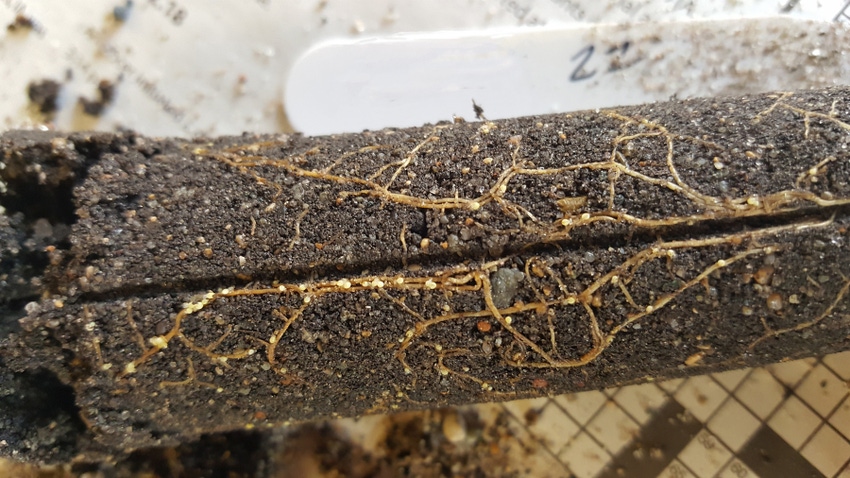August 30, 2023

by Greg Tylka
You may remember the serious concerns that the U.S. soybean industry had about soybean rust almost 20 years ago. Nearly everyone involved in soybean production in the Midwest carefully followed reports of prevailing winds and movements of tropical storms that had the potential to spread rust spores from the southern U.S., where the rust fungus survives over winter, northward to the heart of U.S. soybean production. Fortunately, devastating yield loss from soybean rust in the Midwest never occurred.
However, it may be shocking to learn that there is a major soybean pathogen currently being spread by wind. It reduces soybean yields by an estimated $1.5 billion each year, making it the most damaging soybean pathogen in the U.S. and Canada. The pathogen is the soybean cyst nematode.
Windblown soil
We know that SCN is moved by wind, because adult SCN females develop on the roots of soybeans grown in windblown soil collected from the surface of snowbanks.
Conservation practices should be implemented to reduce wind erosion in all fields in which crops are grown. An added benefit to such practices is they will help reduce or slow the spread of SCN. But there is much, much more that can be done to lessen the economic impact of this pathogen. Simply put, yield loss can be reduced significantly by actively managing SCN.
Sample fields for SCN
Successfully managing SCN requires taking an active approach that begins with identifying whether the pathogen is present in each field where soybeans are or will be grown. Infested fields cannot be identified by appearance. As much as 30% yield loss can occur without aboveground symptoms being apparent.
Fields can be checked for the nematode during the growing season by digging soybean plants from the soil and looking for adult SCN females on the roots. Unfortunately, this can’t be done in the fall after harvest or in the spring before planting.
An easy way to check fields for SCN in the fall and spring is by collecting soil samples and having them processed by a university plant disease diagnostic clinic or private soil-testing laboratory to determine the presence and number of SCN eggs.
Guidelines for fall SCN soil sampling:
Use a soil probe and collect 15-20 soil cores that are 1 inch in diameter and 8 inches deep.
Mix the cores to make one sample representing every 20 acres.
Collect separate samples from different areas of the field based on agronomic features.
Alternatively, collect single soil cores from grid cells if grid sampling is being done, and combine single cores from several individual grid cells to create an SCN soil sample representing a larger sampled area.
Place well-mixed soil samples in wax-lined soil sample bags or plastic bags; label the bags on the outside with a permanent marker, and seal the bags.
Avoid using resealable plastic bags; getting stray soil particles in the seals of these bags causes them to not close properly and bags accidentally open and spill during shipping to a processing lab.
Keep samples at room temperature or below; refrigeration is unnecessary.
This fall, collect soil samples from fields of harvested corn that will be cropped to soybeans in 2024. Soil samples also can be collected this fall from soybean fields after harvest, and results may explain lower-than-expected yields.
Facilities that process SCN soil samples
The Iowa State University Plant and Insect Diagnostic Clinic processes soil samples for SCN. Details and pricing are available online here. Other university plant disease clinics and many private soil-testing laboratories in Iowa and other states and Ontario also process SCN samples. Those facilities are listed at The SCNCoalition.com.
Integrated management
Once SCN-infested fields are identified, farmers need to take a multi-pronged approach to managing the pathogen. Varieties with PI 88788 and Peking SCN resistance genes should be grown as alternating soybean crops in an annual rotation with the SCN nonhost corn. Additionally, numerous nematode-protectant seed treatments are available for farmers to consider using. See TheSCNCoalition.com for more info about all SCN management options.
The SCN Coalition is a collaborative educational program involving university SCN specialists working for industry that can provide guidance on fall soil sampling for SCN.
Tylka is the director of the Iowa Soybean Research Center.
You May Also Like




